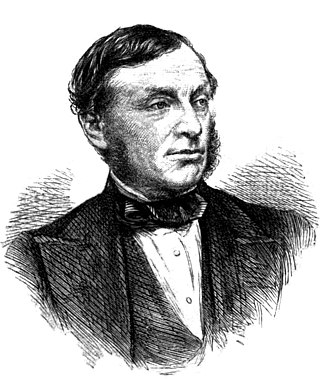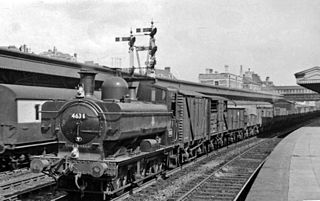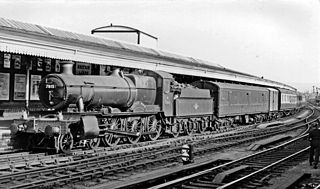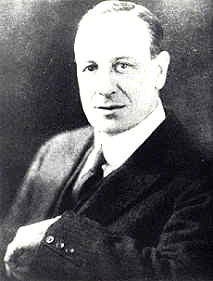Related Research Articles

The 4073 or Castle Class are 4-6-0 steam locomotives of the Great Western Railway, built between 1923 and 1950. They were designed by the railway's Chief Mechanical Engineer, Charles Collett, for working the company's express passenger trains. They could reach speeds of up to 100 mph (160 km/h).
George Jackson Churchward was an English railway engineer, and was chief mechanical engineer of the Great Western Railway (GWR) in the United Kingdom from 1902 to 1922.

Sir Daniel Gooch, 1st Baronet was an English railway locomotive and transatlantic cable engineer. He was the first Superintendent of Locomotive Engines on the Great Western Railway from 1837 to 1864 and its chairman from 1865 until his death in 1889.

The first Locomotives of the Great Western Railway (GWR) were specified by Isambard Kingdom Brunel but Daniel Gooch was soon appointed as the railway's Locomotive Superintendent. He designed several different 7 ft 1⁄4 in broad gauge types for the growing railway, such as the Firefly and later Iron Duke Class 2-2-2s. In 1864 Gooch was succeeded by Joseph Armstrong who brought his standard gauge experience to the workshops at Swindon. To replace some of the earlier locomotives, he put broad gauge wheels on his standard gauge locomotives and from this time on all locomotives were given numbers, including the broad gauge ones that had previously carried just names.

The Great Western Railway 3200 Class was a design of 4-4-0 steam locomotive for passenger train work. The nickname for this class, almost universally used at the time these engines were in service was Dukedog since the locomotives were composed of former Duke Class boilers on Bulldog Class frames. As such they were one of the last standard gauge steam locomotive classes to retain outside frames.

The Great Western Railway 4900 Class or Hall Class is a class of 4-6-0 mixed-traffic steam locomotives designed by Charles Collett for the Great Western Railway. A total of 259 were built at Swindon Works, numbered 4900–4999, 5900–5999 and 6900–6958. The LMS Stanier Class 5 4-6-0 and LNER Thompson Class B1 both drew heavily on design features of the Hall Class. After nationalisation in 1948, British Railways gave them the power classification 5MT.

The GWR 5700 Class, or 57xx class, is a class of 0-6-0 pannier tank steam locomotive built by the Great Western Railway (GWR) and British Railways (BR) between 1929 and 1950. With 863 built, they were the most prolific class of the GWR, and one of the most numerous classes of British steam locomotive.

The Great Western Railway (GWR) 7800 Class or Manor Class is a class of 4-6-0 steam locomotive. They were designed as a lighter version of the Grange Class, giving them a wider Route Availability. Like the 'Granges', the 'Manors' used parts from the GWR 4300 Class Moguls but just on the first batch of twenty. Twenty were built between 1938 and 1939, with British Railways adding a further 10 in 1950. They were named after Manors in the area covered by the Great Western Railway. Nine are preserved.

The Great Western Railway (GWR) 2884 Class is a class of 2-8-0 steam locomotive. They were Collett's development of Churchward's earlier 2800 Class and are sometimes regarded as belonging to that class.

The GWR 1400 Class is a class of steam locomotive designed by the Great Western Railway for branch line passenger work. It was originally classified as the 4800 Class when introduced in 1932, and renumbered in 1946.

The Great Western Railway (GWR) 2800 Class is a class of Churchward-designed 2-8-0 steam locomotive.

The Great Western Railway (GWR) 1500 Class is a class of 0-6-0 pannier tank steam locomotive. Despite being a GWR Hawksworth design, all ten were completed under the administration of the Western Region of British Railways in 1949, just after Nationalisation.

The Great Western Railway (GWR) 1600 Class is a class of 0-6-0 pannier tank steam locomotive designed for light branch lines, short-distance freight transfers and shunting duties.

The Great Western Railway (GWR) 4300 Class is a class of 2-6-0 (mogul) steam locomotives, designed by G.J. Churchward for mixed traffic duties. 342 were built from 1911–1932.

The Great Western Railway (GWR) 5400 Class was a class of 0-6-0 pannier tank steam locomotive. They were similar in appearance to many other GWR tank engines but smaller than the ubiquitous GWR 5700 Class.

Charles Benjamin Collett was Chief Mechanical Engineer of the Great Western Railway from 1922 to 1941. He designed the GWR's 4-6-0 Castle and King Class express passenger locomotives.

The Great Western Railway (GWR) 4700 Class was a class of nine 2-8-0 steam locomotives, designed by George Jackson Churchward. They were introduced in 1919 for heavy mixed-traffic work. Although primarily designed for fast freight, the class also sometimes hauled passenger trains, notably heavy holiday expresses in the summer months. They were called "Night Owls" because they were primarily designed to haul goods during the night and they could be seen simmering in the daylight, awaiting their nocturnal duties.
The GWR was the longest-lived of the pre-nationalisation railway companies in Britain, surviving the 'Grouping' of the railways in 1923 almost unchanged. As a result, the history of its numbering and classification of locomotives is relatively complicated. This page explains the principal systems that were used.
The Great Western Railway (GWR) experimented with oil burning steam locomotives at two points in its history. A single experimental tank engine was constructed to burn oil in 1902, and 37 engines of four different classes were converted to burn oil between 1946 and 1950. Neither experiment resulted in the long-term use of oil as fuel for steam locomotives. A single pannier tank locomotive was also converted under British Rail in 1958.
References
- 1 2 3 4 5 6 Whitehurst, Brian (1973). Great Western Engines, Names, Numbers, Types and Classes. 1940 to Preservation. Oxford: Oxford Publishing. p. 98. ISBN 0902888218.
- 1 2 3 4 5 "GWR oil - fired locomotives". The Great Western Archive. Retrieved 23 September 2018.
- ↑ "Workings of Royal Special Trains in connection with the Funeral of the late King". The Locomotive Magazine and Railway Carriage and Wagon Review. 42 (522): 42–43. 15 February 1936. Retrieved 14 October 2022.
- ↑ "Our Locomotives". Icons of Steam. Retrieved 25 October 2021.
- ↑ Daniel, John. "Castle Class - Windsor Castle". www.greatwestern.org.uk. Retrieved 14 October 2022.
- Haresnape, Brian (1978). Collett and Hawksworth Locomotives—A Pictorial History. Ian Allan Ltd. ISBN 0-7110-0869-8.
- Daniel, John. "4073 'Castle' class". The Great Western Archive. Retrieved 27 December 2008.